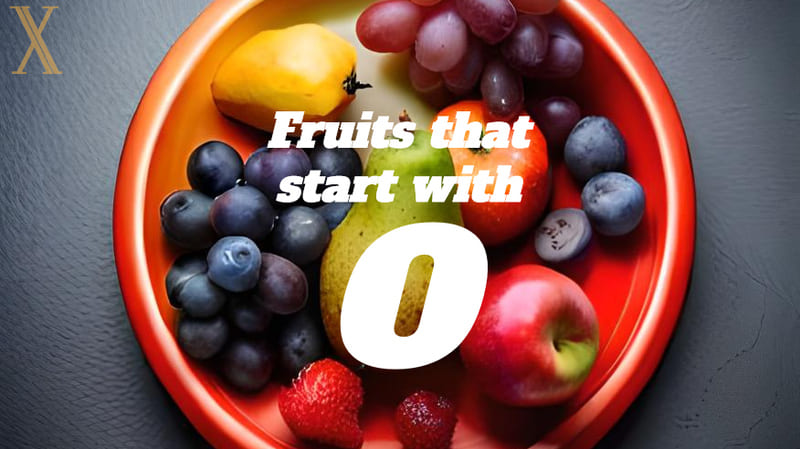
This content covers a variety of unique fruits that start with H, including spicy habanero pepper commonly used in Mexican and Caribbean cuisine, nutty-flavored hackberry often used in baked goods, and hairless rambutan that looks like a lychee without spines. It also includes other fruits such as Hala fruit, Hanepoot grapes, and Hebesu. Each fruit is discussed with its origin, physical attributes, nutritional values, and culinary uses. These fruits not only provide flavor to our dishes but also offer a range of health benefits, making them a great addition to our diets.
Check the entire list in the table of contents.
Habanero
Habanero Pepper, also known as Scotch Bonnet Pepper, is a fiery hot chili pepper commonly used in Mexican, Caribbean, and Central American cuisine. It is small and lantern-shaped and comes in various colors, including red, orange, yellow, and green. Habanero peppers are known for their intense heat and distinct fruity flavor, which is why they are a popular ingredient in spicy sauces, salsas, and marinades. Despite their heat, habanero peppers are also rich in vitamins A and C, making them a healthy addition to any dish.
Hackberry
Hackberry, also known as sugarberry, is a small tree-producing edible fruit. The fruit is small and berry-like and ranges from red to black. It has a sweet, nutty flavor similar to dates or raisins and is often used in baked goods, jams, and jellies. Hackberry trees are also valued for their wood, used to make furniture, flooring, and other decorative items.
Hagberry
Another name for the Hackberry
Hairless Rambutan
Nephelium xerospermoides, the hairless rambutan, is a species closely related to the rambutan. The drupe fruit has a flavor similar to rambutan. However, the fruit has no hair-like spines, hence its common name. They can be eaten freshly picked from the tree. However, they are not commonly grown or harvested for commercial use.
Hala Fruit
Pandanus tectorius is a species of Pandanus (screwpine) tree that produces a large, segmented fruit that resembles a pineapple and can range from 4-20cm in diameter and 8-30cm in length. The fruit comprises 38-200 wedge-like phalanges, each containing two buoyant seeds that can remain viable for many months while being transported by ocean currents. The fruit’s color can be yellow, orange, or red with a green top.
Hall Crabapple
The Hall Crabapple is a small, round fruit commonly used for ornamental purposes native to China. This fruit is part of the rose family and is closely related to apples. It has bright red or yellow skin with tart and slightly sweet flesh, similar to regular apples. The tree is hardy and easy to grow, making it a popular choice for landscaping and decorative purposes.
Hanepoot Grapes
Hanepoot Grapes, also known as Muscat of Alexandria, are a variety of grapes believed to have originated from Egypt. These grapes are large, oval-shaped, and have a greenish-yellow skin with a sweet and musky flavor. Hanepoot grapes are commonly used for making wine, table grapes, and raisins. They are also used in desserts such as fruit salads, sorbets, and tarts. Hanepoot grapes are rich in antioxidants, vitamins, and minerals, making them a nutritious fruit.
Hardy Kiwi
The Hardy Kiwi is a small, sweet fruit similar in taste and appearance to the regular kiwi fruit. It is native to eastern Asia and is grown in cooler climates such as North America and Europe. The Hardy Kiwi is smaller than the standard kiwi and has smooth, edible skin. Its flesh is green and has a sweet and tangy flavor. Hardy Kiwi fruit is a good source of vitamins C and E, fiber, and antioxidants. You can eat it raw or use it in various dishes such as smoothies, salads, and desserts.
Harpephyllum caffrum
Harpephyllum caffrum, also known as the Kaffir Plum or Wild Plum, is a fruit native to southern Africa. It has a greenish-yellow skin with sweet, tangy flesh surrounding a large seed. Harpephyllum caffrum is commonly used to make jams, chutneys, and sauces and can also be used in desserts such as pies and tarts. The tree is hardy and can grow up to 20 meters tall, and its fruit is a good source of vitamins A and C, fiber, and antioxidants.
Haruka
Haruka is a citrus cultivar grown in Japan and the Korean Peninsula. It is believed to be a hybrid between the hyuganatsu and natsudaidai, with the hyuganatsu being the seed parent and the natsudaidai being the pollen parent. The fruit is small to medium, with moderately thick yellow rind and bright yellow flesh separated into 10-11 segments. It is relatively seedy, very sweet, and rather mild in flavor. The fruit is rich in vitamins A and C and contains smaller amounts of B1 and beta-carotene. It is mainly eaten raw and is usually eaten with the pith intact. Haruka is principally cultivated in Ehime and Hiroshima prefectures in Japan and is sold in markets in Japan and exported to Singapore, Taiwan, and Hong Kong.
Hassaku Orange
Discovered in Inno-Shima, Hiroshima prefecture, Japan, the Hassaku orange is a citrus hybrid similar in color to an orange but the size of a grapefruit. Although more tart than an orange, it is still sweet and is mainly eaten raw. The fruit contains vitamin C, folic acid, potassium, and fiber. It is harvested primarily in Wakayama, Hiroshima, Ehime, and Tokushima Prefectures. Unfortunately, the trees are susceptible to Citrus tristeza virus, which causes stunted growth and destroys the harvest after 10–15 years. Nevertheless, an extract from the young fruit is used in skin care treatments for patients with atopic dermatitis.
Hawaiian Raspberry
Hawaiian Raspberry, also known as ‘Ōhelo Berry, is a small, red fruit native to Hawaii. The fruit is similar in size and shape to a raspberry. It grows on a low-lying shrub found in high-elevation areas of the Hawaiian islands. The fruit has a tart and slightly sweet flavor and is often used in desserts, jams, and sauces.
Hawthorn Fruit
Hawthorn fruit, also known as haws, is a small, red fruit that grows on hawthorn trees. The fruit is round and has a tart, tangy, and slightly sweet flavor. The fruit is used in various dishes, including jams, jellies, and sauces. It is also used in traditional Chinese medicine for its health benefits. Hawthorn fruit is believed to help improve digestion, reduce blood pressure, and lower cholesterol levels, among other health benefits. The fruit is usually harvested in the fall and is a popular ingredient in holiday dishes.
Hazelnut
Hazelnuts, cobnuts, or filberts are small, round nuts that grow on hazelnut trees. They have a sweet, nutty flavor and are often used in desserts and confections such as Nutella, pralines, and hazelnut chocolate. Hazelnuts are also nutritious and rich in protein, healthy fats, fiber, vitamins, and minerals. In addition, they are a good source of antioxidants, particularly vitamin E, which helps to protect against cell damage and chronic diseases. People eat them raw or roasted, which are a popular ingredient in many cuisines worldwide, particularly in Mediterranean and Middle Eastern dishes.
Hebesu
Hebesu is a small, yellow, sour fruit that grows on trees in Japan. It is a traditional ingredient in Japanese cuisine, particularly in pickling and preserving. The fruit has a tart, acidic flavor and is often used in sauces, dressings, and marinades. Hebesu is also known for its health benefits, as it is rich in vitamin C, fiber, and antioxidants, which help to boost the immune system and protect against disease.
Heirloom Tomato
Heirloom tomatoes have been passed down through generations of gardeners and farmers. They are typically open-pollinated, meaning they are pollinated by natural means, such as insects or wind, rather than through human intervention. Heirloom tomatoes come in various colors, shapes, and flavors and are often prized for their unique taste and texture. They are also valued for their nutritional content, as they are rich in vitamins, minerals, and antioxidants, which help to protect against disease and promote overall health.
Hickory Nuts
Hickory nuts are the edible nuts of the hickory tree, a hardwood tree native to North America. They have a rich, buttery flavor and are often used in baking, particularly in pies, cookies, and cakes. Hickory nuts are also nutritious and rich in protein, healthy fats, fiber, vitamins, and minerals. In addition, they are a good source of antioxidants, particularly vitamin E, which helps to protect against cell damage and chronic diseases. Hickory nuts can be eaten raw or roasted and are a popular ingredient in many cuisines worldwide, particularly in Southern and Midwestern dishes in the United States.
Highbush Cranberry
Highbush Cranberry is a deciduous shrub that is native to North America. It is not related to true cranberries but got its name due to its similar appearance and taste. The fruit is round, bright red, and slightly sour. It contains vitamins C and K, dietary fiber, and antioxidants. The fruit is often used in making jams, jellies, and sauces. It is also eaten fresh or used as a garnish for salads and desserts. Highbush cranberry is a versatile fruit popular for its unique flavor and culinary uses.
Himalayan Raspberry
Himalayan Raspberry is a shrub that is native to the Himalayas and is widely cultivated in many parts of the world. The fruit is small, red, and has a slightly sour taste. It contains vitamins C and K, dietary fiber, and antioxidants. The fruit is often used in making jams, jellies, and sauces. It is also eaten fresh or used as a topping for cereals and yogurts. Himalayan Raspberry is a popular fruit that is loved by many due to its unique flavor and nutritional benefits.
Himsagar
Himsagar is a type of mango that is native to the Indian subcontinent. It is a small to medium-sized fruit with thin skin and bright yellow color. The flesh is juicy, sweet, and has a unique aroma. It contains vitamins A and C, dietary fiber, and antioxidants. Himsagar Mango is often used in making mango juice, smoothies, and desserts. It is also eaten fresh and used as a topping for salads and other dishes. Himsagar Mango is a popular fruit that many love due to its unique flavor and nutritional benefits.
Hog Plum
Hog Plum, also known as Spondias mombin, is a tropical fruit that grows in South America, the Caribbean, and parts of Asia. The fruit has a tough outer skin ranging from green to yellow. The fruit’s flesh is yellow or orange and has a sour and tangy taste with a hint of sweetness. It is commonly used in chutneys, sauces, and beverages. The hog plum is also used for medicinal purposes in some cultures, as it is believed to have antibacterial and anti-inflammatory properties.
Hollyleaf Cherry
Hollyleaf Cherry, also known as Prunus ilicifolia, is a species of cherry native to the western United States. The fruit is small, about the size of a pea, and bright red when ripe. It has a sweet and tart flavor and is commonly used in jams and jellies. The hollyleaf cherry tree is also used for its ornamental value, as it has shiny, dark green leaves that resemble holly.
Honey Dew
Honeydew melon, or simply honeydew, is a type of melon with a smooth, pale green rind and sweet, juicy flesh. It is a popular summer fruit often used in fruit salads and as a refreshing snack. Honeydew is rich in vitamins and minerals, including vitamin C and potassium, and is low in calories. It is typically harvested in the summer and found in most grocery stores and markets.
Honey Locust
The honey locust, also known as Gleditsia triacanthos, is a deciduous tree native to North America. The tree produces long, flat pods containing sweet, edible pulp. You can eat the pulp raw or use it to make jelly and other sweet treats. Honey locust is also used for their ornamental value. It has delicate, fern-like leaves and can tolerate various growing conditions. In addition, the tree’s wood is solid and durable, making it useful for furniture and other wood products.
Honeyberry
Honeyberry, also known as the edible blue honeysuckle, is a fruit-bearing shrub native to northern regions of Asia and North America. The fruit is small, about the size of a blueberry, and has a deep blue-purple color. The flesh is juicy and sweet with a slightly tart flavor that is often compared to a mixture of blueberries, raspberries, and blackberries. Honeyberries are high in antioxidants, fiber, and vitamin C and are often used in jams, jellies, syrups, and baked goods.
Hophornbeam nut
The hophornbeam nut, also known as the ironwood nut, is the fruit of the hophornbeam tree. The fruit is small and round, with a hard, woody shell that contains a single seed. The seed is edible and has a sweet, nutty flavor. It is often roasted, used as a coffee substitute, or ground into flour and used in baking. The hophornbeam tree is also valued for its strong and durable wood, which is used for making furniture, tool handles, and other products.
Horned Melon
Horned melon, also known as kiwano, is a type of fruit that is native to Africa. It has a distinctive horned shape and bright orange skin with spiky, green protrusions. The fruit is high in vitamin C and fiber and has a sweet, tart flavor with a hint of cucumber. It can be eaten raw, added to fruit salads, or used in smoothies. The fruit is also used in traditional African medicine to treat various health conditions, including high blood pressure and respiratory problems.
Horse Mango
Mangifera foetida, also known as horse mango, malmut, limus, bachang, and machang, is an endemic tree to Indonesia, Malaysia, Burma, Singapore, Thailand, and Vietnam and grows in humid tropical areas up to 1000 meters above sea level. It has elliptical to ovate leaves that are 15 to 40 centimeters long and 9 to 15 centimeters wide. The tree’s fruit is almost spherical, 7-16 centimeters long, and ranges in color from olive green to yellow. The flesh is fibrous and can be either tart or sweet. The tree produces a strong irritant latex that is a quick irritant to the skin. The fruit is used for food, while the seeds treat scabies and eczema.
Horseradish tree fruit
The Horseradish tree fruit, mainly known as “Moringa fruit,” is a superfood loaded with nutrients and health benefits. It is a long, slender, green fruit that resembles a bean pod and is native to India and Southeast Asia. The fruit tastes bitter and is usually eaten raw or cooked, and its leaves are also edible. They are commonly used in salads, soups, and curries. The Horseradish tree is also known for its medicinal properties and is, therefore, used to treat various ailments, such as diabetes, high blood pressure, and inflammation. The Horseradish tree is a fast-growing plant that can thrive in multiple climates, making it an excellent addition to any home garden.
Hottentot Fig
Hottentot Fig, also known as “Carpobrotus edulis,” is a succulent fruit native to South Africa. The fruit is small, round, and has a fleshy, sweet interior that tastes like a mix of honey and strawberries. The Hottentot Fig plant is a ground cover that produces bright yellow flowers that bloom during summer. The fruit is also commonly used in jams, jellies, and desserts and is sometimes eaten raw.
Huckleberry
Huckleberry is a name used in North America for several plants in the family Ericaceae, in two closely related genera: Vaccinium and Gaylussacia. The fruit is generally harvested in the wild but also cultivated in some regions. The fruit is small, about the size of a pea, and has a slightly tart and sweet taste. It is often used in desserts such as pies, jams, and syrups, and it is also used in savory dishes such as sauces and marinades. Huckleberries are known for their high nutritional content and are rich in antioxidants and vitamin C. They are also low in calories and fiber, making them a healthy addition to any diet.
Huito
Huito is a fruit that is native to South America and is grown in the Amazon rainforest. It is also known as Genipa or Genipap fruit. The fruit is round and has a rugged, woody shell that encloses a pulpy interior. The fruit is typically consumed when it is ripe, and the pulp is sweet and has a unique flavor that is often described as a mixture of mango and passion fruit. The fruit is often used to make juice, jams, and ice cream. In addition to its culinary uses, Huito is also used in traditional medicine to treat various ailments such as fever, diarrhea, and respiratory infections.
Hummingbird tree fruit
The Hummingbird tree fruit, also known as Sesbania grandiflora or Agati, is a fruit that is native to Asia and is commonly found in tropical and subtropical regions. This fruit is pod-shaped, hanging, and segmented, 20-55 cm long. When young, it is green, while it turns yellowish-white when ripe. The seeds are elongated and brownish. The tree is also used for its timber, and the leaves are used as fodder for livestock.
Husk Tomato
Husk tomato, also known as Mexican groundcherry, is a small, round fruit closely related to the tomato. The fruit is enclosed in a papery husk, which is removed before eating. Husk tomatoes have a sweet, tangy flavor that is often compared to pineapple or cherry, and they can be eaten raw or cooked in various dishes. They are often used in jams, pies, and sauces and are popular as a snack or garnish. Husk tomatoes are relatively easy to grow and can be cultivated in home gardens or small farms.
Hyuganatsu
Hyuganatsu is a type of citrus fruit that is native to Japan. It is similar in appearance to a grapefruit, with a round shape and a thick, yellowish-orange rind. The flesh of the fruit is juicy and fragrant, with a tart and slightly sweet flavor. Hyuganatsu is often used in desserts and drinks and is also popular as a garnish or flavoring agent. The fruit is generally in season from late winter to early spring and is considered a delicacy in Japan.
-

The A-List of Fruits: A Journey Through Fruits that Start with A
-

Fruits that Start with B: A Guide to the Best of the Bunch
-

Discover the Sweet World of Fruits That Start with C
-

Fruits That Start with D: Discovering Exotic Flavors
-

15 Fruits That Start With E: A Delicious Guide
-

23 Fruits that Start with F: A Guide to Nutritious Options
-

Fruit Alphabet: Discovering Fruits that Start with G
-

Fruits that start with H: From Habanero Pepper to …
-

22 Fruits That Start With I: Nutritious and Medicinal Treasures
-

25+ Fruits that Start with J: A comprehensive list
-

35+ Fruits that Start With K (with a short description)
-

Fruits that Start with L: From Lablab to Lychee
-

The Mighty M’s: A Guide to Fruits That Start with M
-

Fruitful N: Discovering Exotic Fruits That Start With N
-

The Encyclopedia for the Fruits That Start with O
